ROMEIROS DE S. MIGUEL – PT3
ROMEIROS - ORATÓRIO SANTO ANTÓNIO
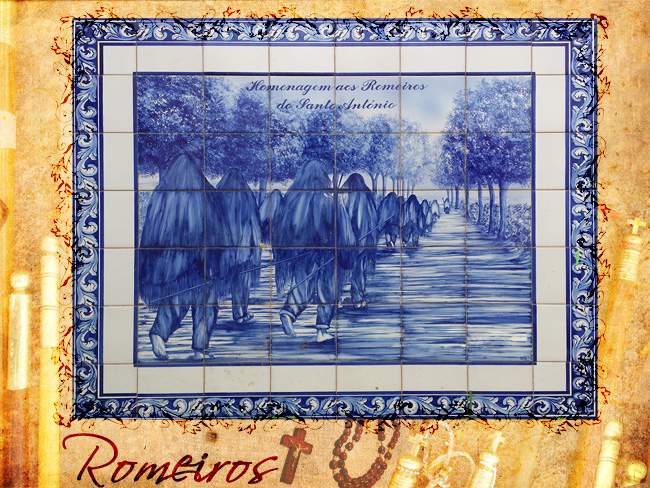
Português

Romeiros - Uma tradição de Fé
“Seja para sempre louvada a Sagrada Vida, Paixão, Morte e Ressurreição de Nosso Senhor Jesus Cristo”
É assim que os Romeiros se saúdam entre si e a todos os outros com quem se cruzam.
Esta é uma tradição secular, micaelense, onde grupos de homens de Fé, caminham, em romaria, de Igreja em Igreja (geralmente dedicada a Nossa Senhora), a rezar por si e por todos… Esta tradição, que se repete quase há 500 anos apareceu, mais recentemente, também, nas ilhas: Graciosa e Terceira.
Estes grupos (chamados ranchos), de origem paroquial, caraterizam-se por “caminhar”, na quaresma e durante oito dias, no sentido dos ponteiros do relógio, de Igreja em Igreja (ou Ermida), sempre rezando ou cantando a “Avé Maria”, típica destas romarias. Saem por volta das quatro da manhã e chegam à freguesia onde vão pernoitar, geralmente ao pôr do sol, celebrando-se, então, a Eucaristia.
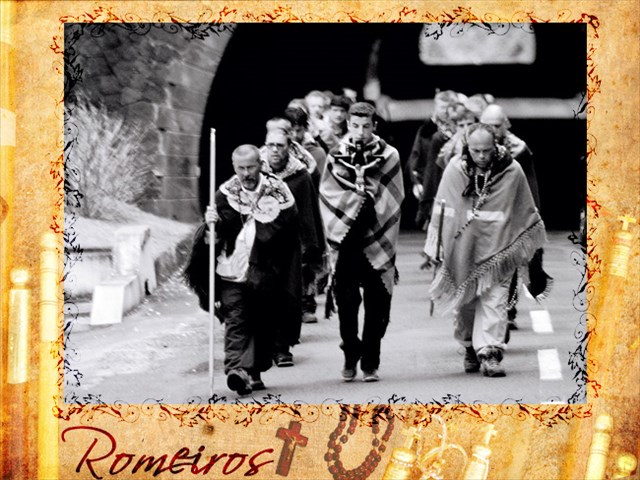
São Homens pecadores, mas verdadeiros crentes, que se tratam por irmãos e que, de fato, agem uns para com os outros desta forma, durante todo o ano. Cada rancho é constituído por um Mestre (responsável pelo Rancho), um contra -mestre, por dois guias, por um procurador das almas, por um lembrador das almas, pelo cruzadinha (jovem ou criança que transporta a cruz) e por um ou dois ajudantes, que podem ser os despenseiros (irmãos que tratam da alimentação do rancho).
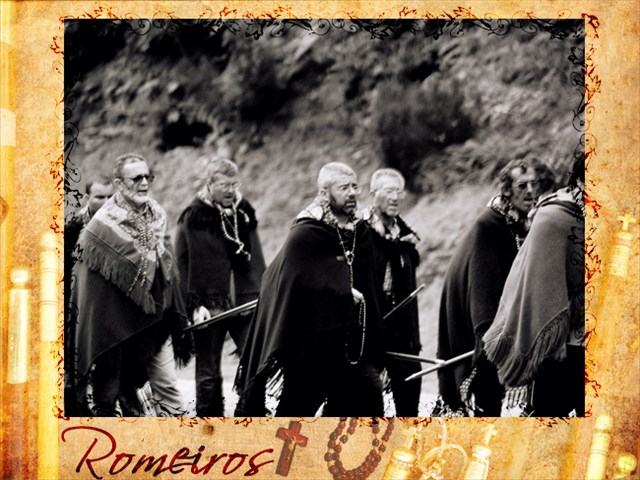
Da sua indumentária é tradição e obrigatório, usar: um bordão (que ajuda na caminhada e representa o cetro de Cristo), o xaile (que representa a capa de Cristo), o lenço (que representa a coroa de espinhos), a cevadeira ou sovadeira (saco transportado às costas com tudo aquilo que é necessário para aquela semana) e, pelo menos, dois terços.
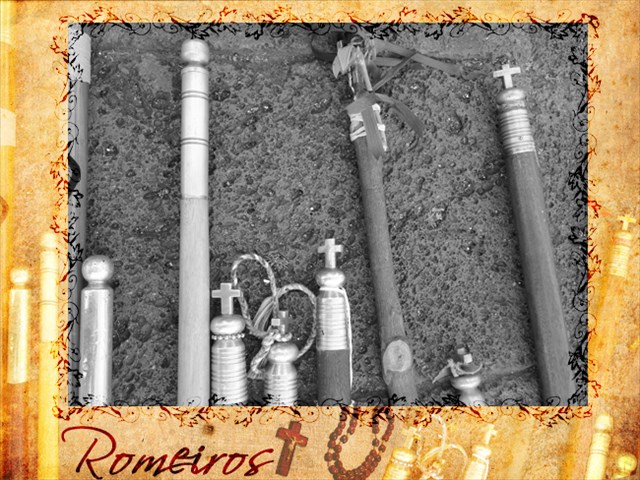
Podemos dizer que os romeiros rezam por si e por toda a ilha (através das orações pedidas ao procurador das almas do rancho).
É importante referir que os “irmãos” ficam a dormir nas casas de “irmãos”, geralmente desconhecidos, que lhes dão pernoita em cada noite da romaria e em cada paróquia onde o rancho chega no final de cada dia. Registe-se que os romeiros são recebidos em cada uma destas casas, como se de o verdadeiro Cristo se tratasse. Na maior parte dos casos são famílias verdadeiramente humildes que dão guarida (no mínimo aos pares), aos romeiros.
Nesta semana, verifica-se uma grande profundidade de sentimentos, criando-se um verdadeiro espírito de união e amizade, entre todos os homens que compõem cada rancho de romeiros. É um tempo de grande reflexão, onde cada irmão se encontra no silêncio da caminhada.
A origem das Romarias Micaelenses
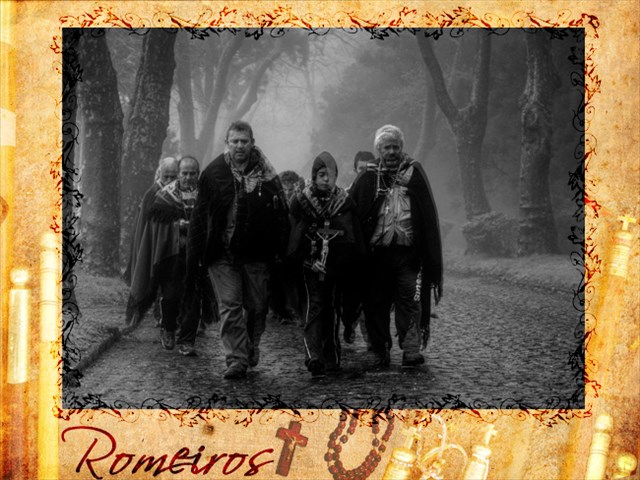
Tradição oriunda de S. Miguel, ilha do Arquipélago dos Açores, as romarias quaresmais tiveram a sua origem, segundo se crê, no início do século XVI, em Vila Franca do Campo, primeira capital da ilha. Constituíram a resposta encontrada pela população de então para aplacar a fúria divina que, assolando essa localidade, soterrou os vila-franquenses e todos os seus haveres.
Na sequência desta catástrofe natural, ocorrida no dia 22 de Outubro de 1522, os poucos sobreviventes ergueram uma ermida, consagrada a Nossa Senhora do Rosário, no local onde actualmente existe o Convento de S. Francisco. Todas as quartas-feiras, dia da semana em que ocorrera a catástrofe, a população da ilha, à noite, dirigia-se em romaria a esse local.
Com o passar dos anos, algumas paróquias começaram a organizar romarias, que, ao longo de oito dias, percorriam a ilha a pé, parando em todas as igrejas onde fosse venerada a Virgem e/ou onde estivesse o Santíssimo Sacramento. Os romeiros dirigiam-Lhes súplicas, agradecendo-Lhes as graças concedidas. Durante o percurso, entoavam o hino de Nossa Senhora (Avé Maria).
No ano de 1962, o Bispo da diocese, D. Manuel Afonso de Carvalho, promulgou o Regulamento dos Romeiros, vinculando os responsáveis pelos ranchos ao cumprimento do mesmo, assim como à realização de reuniões prévias, de preparação. Essa orientação foi continuada por D. Aurélio Granada Escudeiro, em cujo episcopado foi criado o Grupo Coordenador das Romarias Quaresmais de S. Miguel. Coube a este grupo a alteração do Regulamento até então em vigor.
O local onde está a cache é um lugar por onde passam e rezam muitos Ranchos de Romeiros.
Sobre a CACHE:
Por existir uma cache a menos de 161m, esta não se encontra nas coordenadas indicadas.
Para poder chegar à localização final tem de efetuar a seguinte operação:
A = Ano da data existente no canto inferior direito do painel de azulejos "Homenagem aos Romeiros de Santo António"
Coordenadas Finais:
N 37° 52.(A-1979) W 025° 42.(A-1413)
A caixa tem um formato convencional.
Por favor, sejam discretos, não façam logs forçados, nem postem fotos que possam denunciar a cache.
Deixem o contentor tal como o encontraram!
English

Pilgrims - A Tradition of Faith
"Be Forever praised the Holy Life, Passion, Death and Resurrection of Our Lord Jesus Christ"
This is how the Pilgrims greet each other among themselves and all others with whom they meet.
This is a secular, Azorean tradition where groups of men of Faith, go on pilgrimage, from Church to Church (usually dedicated to Our Lady), praying for themselves and for all... This tradition, is repeated for almost 500 years. This tradition appeared more recently in the islands: Graciosa and Terceira.
These groups (called ranches). They walk for eight days during Lent in a clockwise direction, from Church to Church (or Chapel), always praying or singing the "Hail Mary" typical of these pilgrimages. They leave around four in the morning and arrive at the parish (usually at sunset) where they will stay for the night, where is celebrated the Eucharist.
They are sinners, but true believers who treat themselves by brothers. Each ranch consists of a Master (responsible for the Ranch), one foreman, two guides, an attorney of souls, an reminder of souls, a young child who carries the cross and one or two helpers, which may be the stewards (brothers dealing with supply ranch).
The traditional dress code is mandatory: a stick (which helps in walking and is the scepter of Christ), shawl (which is the cover of Christ), scarf (which is the crown of thorns), a bag carried on his back with everything that is needed for that week and at least two Rosary.
We can say that the pilgrims pray for you and for all the people of the island (The prayers are asked from the people to the attorney of souls of the ranch).
It is important to note that the "brothers" are sleeping in the homes of other "brothers", usually unknown to them, giving them overnight in the pilgrimage every night and in every parish where the ranch arrives at the end of each day. It is noted that the pilgrims are received in each of these houses, as if it were the true Christ. In most cases are truly humble families who give shelter at least to two pilgrims.
This week, there is a great depth of feeling, creating a true spirit of unity and friendship among all men that make up each ranch pilgrims. It is a time of great reflection, where each brother is in the silence of the hike.
The origin of São Miguel Pilgrimages
This tradition begun in S. Miguel Island in the Azores. The Lenten pilgrimages had their origin,in the early sixteenth century, in Vila Franca do Campo, the first capital of the island. They were the answer of the population to appease the divine fury that buried the village and all their possessions.
Following the natural disaster, which occurred on 22 October 1522, the few survivors erected a chapel, dedicated to Our Lady of the Rosary, where currently there is the Convent of S. Francisco. All Wednesdays, day of the week in which the disaster occurred, the population of the island at night, went on a pilgrimage to this location.
Over the years, some parishes began organizing pilgrimages, which over eight days, roamed the island on foot, stopping at every church where the Virgin was venerated and/or where was the Blessed Sacrament. The pilgrims headed Them supplication, thanking them for the graces granted. Along the way, they sing the hymn of Our Lady (Hail Mary).
In 1962, the Bishop of the Azores, D. Manuel Afonso de Carvalho, promulgated the Regulation of the Pilgrims, that ranches responsible must fulfill, as well as the preparation meetings that all the pilgrims must attend. This policy was continued by D. Aurélio Granada Escudeiro, in whose episcopate was created the Coordinating Group of Pilgrimages Lenten of S. Miguel. The group had the task to change the regulation that is valid till today.
The cache location is a place where many ranches Pilgrims pass by and pray.
About the Cache:
Because there's a cache less than 161m, this cache is not at the given coordinates.
To get to the final location you must perform the following operation:
A = Year of the date in the lower right corner of the tiles panel "Homenagem aos Romeiros de Santo António"
Final Location:
N 37° 52.(A-1979) W 025° 42.(A-1413)
The cache has a conventional format.
Please be discreet, don't do forced logs, or post photos that can lead to the cache
Leave the container as you found it!